Rights in the Copyright System
In this
paper I start with a review of some of the rights applied to intellectual
property under the copyright regime and an analysis of when these
rights take effect. I then highlight the the difficulties facing
copyright by the intrinsic nature of the digital environment to
make copies of a work as it transits the digital landscape. Finally,
I discuss how, by treating 'rights' as the commodity rather than
individual copies, the Distributed Intellectual Property Rights
(DIPR) system might reintroduce the
balance between the free flow of creative work and incentives for
the author without the need for restrictive access controls.
Copyright
The Rights
A bundle of rights applied to creative intellectual property, such
as:
-
- To reproduce the work in copies
-
- To prepare derivative works
-
- To distribute copies of the work to the public by sale or
other transfer
-
- To perform the work publicly
-
- To display the copyrighted work publicly
-
- Right of attribution
Of course, there are limitations to some of these rights such the
'first sale' and 'fair use' doctrines.
Who owns these
rights?
-
Only the author or those deriving their rights through the author.
-
The employer, not the author, in 'works made for hire'.
-
More than one author can be co-owners of the copyright for a
joint work.
-
Any or all of the copyright owner's exclusive rights or any
subdivision of those rights may be transferred to another.
Collective Rights
As a general rule – A collective or group of people can be
a legal person capable of owning rights.
Sir John Salmond's dictum that:
'A legal person is any subject matter to which the law attributes
a merely legal or fictitious personality. The extension,
for good and sufficient reasons, of the conception of personality
beyond the limits of fact - this recognition of persons who
are not men - is one of the most noteworthy feats of the
legal imagination.'
Copyright already allows collective or group ownership of copyrights.
Division of Rights
As a general rule - Property can be 'stratified' in such a way that
different right holders can have rights over different 'strata'.
On the theory that 'property' is a 'bundle of rights' (and copyright
appears to fit this theory) I believe it is established that different
rights from the 'bundle' can be held by different entities.
Common Rights
By this I mean – Natural rights common to each individual.
Rights such as free speech.
In the case of one individual recounting a story to another, both
individuals are exercising their common rights, one to tell the
story the other to listen to it.
Someone reading a book is exercising their common right of transferring
the intellectual content of the book to their mind. Copyright does
not regulate reading because it does not involve reproducing any
tangible copy. The reader is not obliged to read the title page
and so even the authors 'right of attribution' only applies to tangible
copies.
You can conclude from the above that both the author and the 'someone'
reading the book have the common right to hold the intangible content
in their minds.
When are Rights Exercised (a schematic point of view)
Symbols
used:
 |
Intangible intellectual content in the mind of an individual
for instance. |
 |
Tangible copy of an intellectual work. |
 |
Transmission of intellectual content. Rights are exercised
at the points of initiation and termination of the transmission. |
The
analogue world:
Transmission of unregulated intellectual content from one individual
to another takes the form of the author exercising his or her common
right of free speech while the consumer exercises his or her right
to listen:
Transmission
of intellectual content via the tangible medium of a book follows
the process shown below:
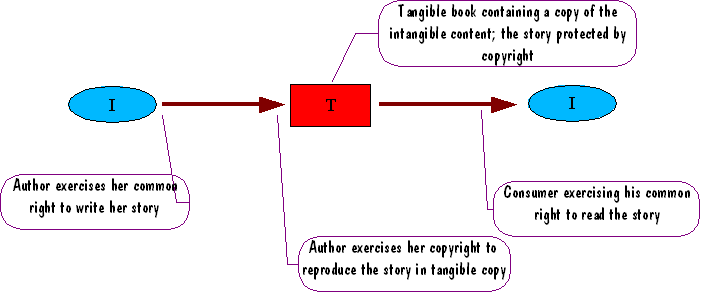
Reproduction
of tangible copies is regulated by the author's copyright and the
subsequent sale or transfer of these copies to the public is also
the author's privilege:
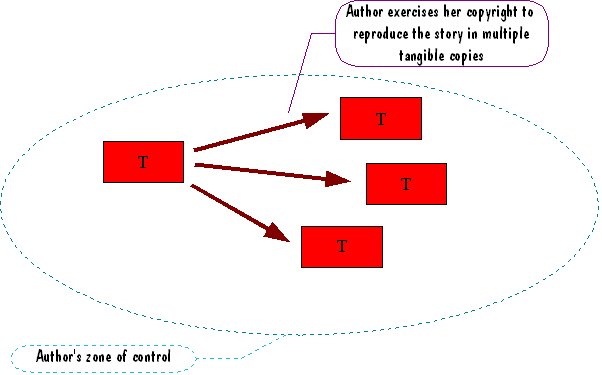
Under
the 'first sale' rule, trading of tangible copies after the author
has sold or otherwise transferred a copy to another individual is
outside the author's copyright control:
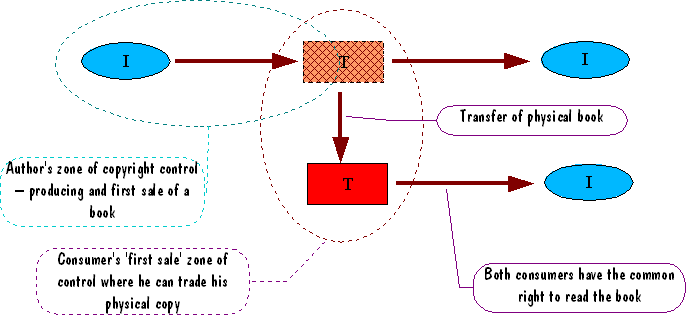
Public
performances do not involve tangible copying but the author's copyright
constrains the entity performing the work:
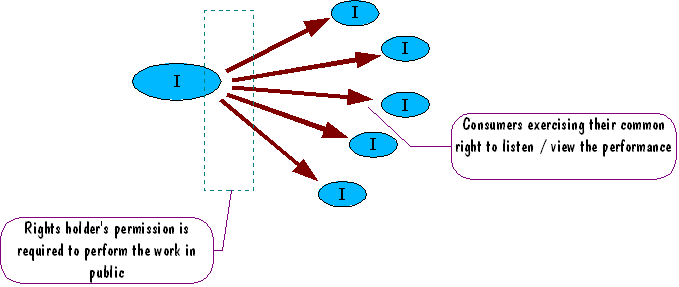
As
for the public performance, the analogue broadcasting of an intellectual
work does not involve the reproduction of the work in copies but
the broadcast still requires reimbursement of the rights holder.
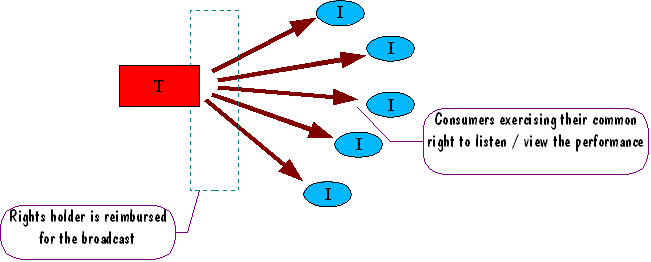
The
digital world:
If the author wishes to distribute copies of their work via a digital
environment, such as the Internet, it immediately introduces a complication;
the transfer of 'the copy' involves multiple copying operations
and possibly the existence of multiple copies at any one time.
The
Digital Complication
The authors sole right to reproduce the work in a digital environment,
where multiple copies come and go, makes no sense unless she controls
(owns) the whole digital environment. Under the current circumstances
copyright holders and consumers have three ways of dealing with
this complication:
-
The rights holder issues one copy and the consumer relies on
the extension of the 'fair use' dispensation to allow him or
her to make as many copies as necessary to facilitate their
access to the content. This can work but I believe it produces
an unsatisfactory situation for many reasons:
-
It stretches 'fair use' doctrine beyond all recognition. The
copyright limitation allowing reproduction of a small portion
of the work, as a quotation for example, becomes untold numbers
of wholesale copies and this process of making copies may need
to be repeated throughout the consumers period of ownership.
-
Who is responsible for operational copies that get left on the
computer systems involved.
-
What happens to the 'first sale' rule?
-
The consumer appears to be in a weak position if they have to
justify their copying activities.
-
The rights holder issues a copyrighted copy and also obliges
the consumer to enter into a contract or licence agreement which
specifies the consumers use of the product. Effectively, the
rights holder maintains legal control over the copy they sold
to the consumer. Where does this leave the consumer and his
or her rights? Apply iTunes works on this formula.
-
Digital Rights Management (DRM) is applied to the problem. Technical
controls are used to control the consumers use of the work.
Again, where does this leave the consumer? With the added complication
that this technological control can infringe the consumer's
privacy.
2. and 3. can result in the schematic representation of rights as
shown below:

The
Distributed Intellectual Property Rights (DIPR) Solution
Under the DIPR scheme the consumer
purchases a reproduction right not a copy.
The
rights transfer is established by the exchange of two unique identifiers.
This process and the rest of the DIPR system is described on the
Common Rights Web site.
As intellectual property is the perfect 'public good', truly non-rival,
I see no problem with this transfer of a reproduction right to an
identified manifestation of an intellectual work. It can be thought
of in two ways:
-
Collective Rights - The author and a (purchasing) consumer become
co-owners in the reproduction right of that unique manifestation.
Co-ownership is registered by the 'rights offices' in the DIPR
system. Or,
-
Division of Rights - The intellectual product is 'stratified'
by the allocation of the numerous unique identifications and
paying customers obtain rights over individual 'strata'.
Lawyers, it appears, are not enthusiastic about two individuals
owning rights to a single item of property therefore, maybe, the
second option is the preferable way of dealing with the transfer
of rights. In this case a new author's right could be defined; a
'symbolic' or 'subrogation' right where the author has the additional
exclusive right to issue unique identifiers that represent a manifestation
of the creative work. The unique identifier issued to a consumer,
in turn, can substitute this consumer as the holder of certain rights
to the work.
How might the DIPR solution change the copyright landscape?
-
- To reproduce the work in copies
Initially this right rests with the author when they first
create an original work. Any subsequent transfer of a 'copy'
of the work combined with the issue a new identifier,
under the DIPR system, results in the transfer of a reproduction
right for that unique manifestation of the work.
Result – This strengthens the position of the consumer.
-
- To prepare derivative works
This right rests with the author, however, since the DIPR
environment establishes a system of 'transferring' rights the
right to make derivative works could selectively be allocated
to consumers. Any other right of the author can also be transferred
but the consumer can not further share or pass-on the rights
they 'co-own' with the author without the author's consent.
Result – Neutral
-
- To distribute copies of the work to the public by sale or
other transfer
The right to distribute copies does not pass to the consumer
with the transfer of the reproduction right. Under the DIPR
proposal there needs to be a very firm distinction between commercial
and non-commercial. The commercial rights rest with the author
unless, of course, she chooses to pass these on.
Under the DIPR system the 'first sale' rule ceases to exist
– the transfer of reproduction rights conveys no transfer
or commercial rights (identification rights) what-so-ever.
Result – strengthens the author's position.
-
- To perform the work publicly
No change from rights point of view but see broadcast below.
-
- To display the copyrighted work publicly
No change
-
- Right of attribution
Every copy or manifestation is attributed to the author through
the author's persistent identifier.
Even if she transfers all her exclusive rights to another entity
the original manifestations will still be attributed to the
author.
Result – strengthens the author's position.
-
- Right to issue identified manifestations
A new right to ensure that only the author, or those deriving
the right through the author, can issue identified works into
the DIPR environment.
Result – strengthens the author's position.
This
analysis can continue to other areas of intellectual property and
the distribution on intellectual works. Some further analysis is
covered on the DIPR
web site. Adopting the DIPR system introduces many interesting possibilities
for new distribution and business models but one area of special
interest for this rights discussion is broadcast
.
Digital Broadcasting
When a work is broadcast in the analogue world the rights holder
is exercising his or her commercial rights; no transfers of copies
is involved, ignoring home recording for the moment. The audience
pays the broadcaster, somehow (subscription, via advertising), to
receive the content and the broadcaster pays the composer either
directly or through a collecting society.
Digital broadcasting changes the situation in the same way that
the digital environment has changed the transfer of copies. Take
web-casting or streaming over the Internet where multiple copies
are involved rather than one continuous analogue transmission. I
propose that 'broadcasts' under the DIPR system will become another
reproduction right – the broadcaster triggers off multiple
copies. The DIPR environment has two options for identifying the
broadcast content:
-
Both identifiers of the broadcast copy are allocated to the
author or broadcast right holder and therefore any broadcast
copy can only legally pass though the digital system to its
intended destination. Any further copying is not authorised.
-
Each broadcast copy can have a unique customer identification.
In this case the customer can keep a copy under the limited
reproduction conditions that are defined for any other copy
in the system.
Conclusion
In
this paper I have simplified the analysis by limiting the rights
considered to a single author rather than multiple entities such
as composers, recording artists, and others who might hold rights.
I have done this to show the principle and the need for transferring
rights rather than copies in digital environments.
I have also suggested how the sub-division and co-owning of property
rights is already established and that there is no reason why this
principle should not be applied to intellectual property for wide
scale rights ownership.
One of the major advantages of the DIPR system is that the rights
management of intellectual property, from the technical point of
view, can be limited to the 'rights
office' structure on the Internet. This is much more feasible
and less intrusive than trying to control digital copies of creative
works throughout the supply chain and consumer media environment.
|



